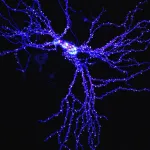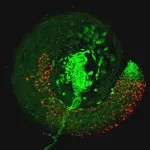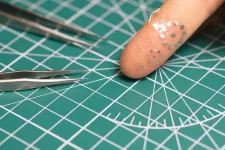(Press-News.org) SAN ANTONIO, March 7, 2024 – The University of Texas Health Science Center at San Antonio (UT Health San Antonio) has secured approximately $16.4 million in funding from the Cancer Prevention and Research Institute of Texas the past six months, attracting three top cancer researchers and advancing child and adolescent cancer research.
A primary driver of San Antonio’s leading $44.1 billion health care and biosciences sector, UT Health San Antonio is the largest academic research institution in South Texas with an annual research portfolio of $413 million, and accounts for more than 70% of National Institutes of Health research funding to all institutions locally.
Simon Gayther, PhD, a renowned cancer researcher at Cedars-Sinai Medical Center whose breakthrough studies have focused on understanding the underlying causes of ovarian cancer initiation and development, will join Mays Cancer Center and the Department of Medicine at UT Health San Antonio next month, from $6 million in CPRIT funding approved Aug. 16. Also that month, $999,999 was approved by CPRIT to expand a program of human papillomavirus (HPV) vaccination among survivors of childhood cancer.
Another $6 million CPRIT recruitment award, approved in February, will bring Anna Malkova, PhD, from the University of Iowa to UT Health San Antonio on April 8, joining as a full professor in the Department of Biochemistry and Structural Biology. A $2 million CPRIT recruitment grant already has brought Yu Luan, PhD from Northwestern University, joining as an assistant professor in the Department of Cell Systems and Anatomy and an investigator with UT Health San Antonio’s Greehey Children’s Cancer and Research Institute.
And Katsumi Kitagawa, PharmD, PhD, associate professor in the Department of Molecular Medicine in the Joe R. and Teresa Lozano Long School of Medicine at UT Health San Antonio and investigator in Greehey Institute, received $1.4 million to advance research into Ewing Sarcoma, the second most common primary malignant bone tumor in children and adolescents.
Gayther will join as professor of medicine, Mays Family Endowed Chair in heritable oncogenesis and inaugural director of the school’s Center for Heritable Oncogenesis. Oncogenesis refers to the induction or formation of tumors.
He will be part of the Population Science and Prevention Program of Mays Cancer Center, one of only four National Cancer Institute-designated Cancer Centers in Texas. He will devote most of his effort to his internationally acclaimed research program in genetic epidemiology and functional biology of risk variants associated with ovarian, breast and prostate cancers.
“Dr. Gayther will add transformative expertise to our cancer-focused programs, help recruit outstanding investigators to further strengthen our Population Science and Prevention Program, help achieve our institutional vision of becoming a premier research center in understanding the molecular bases of oncogenesis, and bolster our outreach and education in cancer science, and the discovery and development of novel therapeutics,” said Patrick Sung, DPhil, professor of biochemistry and structural biology, director of the Greehey Institute and interim executive director of Mays Cancer Center.
Gayther’s particular emphasis will be on explaining the multi-factor basis of familial and sporadic breast and ovarian cancer stemming from mutations in the tumor suppressor genes BRCA1 and BRCA2 – and how ancestry, environmental exposures and lifestyle affect cancer susceptibility, progression and treatment outcome. He also will mentor graduate students in the PhD and MD/PhD tracks from the school’s Integrated Biomedical Sciences Graduate Program.
Malkova will become the Mays Family Endowed Chair in DNA Repair Genetics and a member of both the Greehey Institute and the Cancer Development and Progression Program of Mays Cancer Center, as well as a mentor in the Integrated Biomedical Sciences Graduate Program.
“We are thrilled to have Dr. Malkova join our faculty and add an exciting new dimension of research to our overall efforts in DNA repair and cancer biology,” said Reuben Harris, PhD, professor and chair in the Department of Biochemistry and Structural Biology and esteemed Howard Hughes Medical Institute Investigator. “This will stimulate many new collaborations and undoubtedly lead to new cancer therapy insights.”
Luan’s laboratory is dedicated to the detection and characterization of epigenetic and chromatin topology alterations during tumorigenesis (the formation or production of tumors), and focused on developing algorithms and computational tools to explain the impact of genetic variants and transposable elements on human diseases.
“Dr. Luan is key to realizing our institutional goal of a world-class blood cancer research program and is expected to help drive the development of new, efficacious treatment regimens for pediatric Ph-like ALL and relapse prevention,” said Christi Walter, PhD, professor and chair in the Department of Cell Systems and Anatomy. “Luan’s research will synergize with existing investigators and programs for the clinical translation of findings, nucleate team science projects and grant applications and advance our training and mentoring missions.”
Kitagawa’s research targets therapy for chromosome instability in Ewing Sarcoma cells, as these cells display frequent chromosome gains or losses. How this instability occurs is unknown, though Kitagawa’s focus is on dysfunctional centromeres that mediate chromosome segregation.
“CPRIT’s support will enable Dr. Kitagawa to develop novel therapeutic strategies for treating Ewing Sarcoma, a common pediatric bone cancer,” Sung said.
The University of Texas Health Science Center at San Antonio (UT Health San Antonio) is one of the country’s leading health science universities and is designated as a Hispanic-Serving Institution by the U.S. Department of Education. With missions of teaching, research, patient care and community engagement, its schools of medicine, nursing, dentistry, health professions, graduate biomedical sciences and public health have graduated more than 42,550 alumni who are leading change, advancing their fields and renewing hope for patients and their families throughout South Texas and the world. To learn about the many ways “We make lives better®,” visit UTHealthSA.org.
Stay connected with The University of Texas Health Science Center at San Antonio on Facebook, Twitter, LinkedIn, Instagram and YouTube.
The Mays Cancer Center at UT Health San Antonio is one of only four National Cancer Institute-designated Cancer Centers in Texas. The Mays Cancer Center provides leading-edge cancer care, propels innovative cancer research and educates the next generation of leaders to end cancer in South Texas. To learn more, visit https://cancer.uthscsa.edu.
Stay connected with the Mays Cancer Center on Facebook, Twitter, LinkedIn, Instagram and YouTube.
The UT Health San Antonio Joe R. and Teresa Lozano Long School of Medicine is listed among U.S. News & World Report’s best medical schools, ranking in the top 30% nationwide for research. To learn more, visit https://uthscsa.edu/medicine/.
The Greehey Children’s Cancer Research Institute is one of only two institutes in the United States dedicated solely to pediatric cancer research. Its 18 laboratories focus their strengths on cancer genomics, DNA repair, RNA biology and drug development in finding new and less toxic treatments for childhood cancers.
END
UT Health San Antonio receives $16.4 million from CPRIT over six months, adding transformative expertise, bolstering cancer research
2024-03-07
ELSE PRESS RELEASES FROM THIS DATE:
Current state of dermatology mobile applications with AI features
2024-03-07
About The Study: This scoping review determined that although artificial intelligence (AI) dermatology mobile apps hold promise for improving access to care and patient outcomes, in their current state, they may pose harm due to potential risks, lack of consistent validation, and misleading user communication. Addressing challenges in efficacy, safety, and transparency through effective regulation, validation, and standardized evaluation criteria is essential to harness the benefits of these apps while minimizing risks.
Authors: Veronica Rotemberg, M.D., Ph.D., of Memorial Sloan Kettering Cancer Center in New York, and Associate Editor, JAMA Dermatology, is the corresponding ...
Surprise: Egg-laying amphibian provides nutrient-rich “milk” to its young
2024-03-07
An egg-laying species of worm-like amphibian feeds a lipid-rich milk-like substance to its hatchlings, according to a new study. The findings report a previously unobserved behavior and offer new insight into the species’ parental care and communication. Among vertebrates, the embryonic yolk is often the only nutritional investment mothers offer to feed offspring. However, some species have developed parental care behaviors involving the production and provisioning of specialized foods, such as the production of lipid-rich milk in mammals. Feeding offspring with nutrient-rich milk was long seen as a trait unique to mammals. However, several non-mammalian ...
Fishing for oil and meat drives deepwater shark and ray decline
2024-03-07
The international liver oil and meat trade is driving rapid depletion of deepwater sharks and rays – an outcome that is potentially irreversible due to these animals’ extremely slow life histories. The findings highlight the need for immediate trade and fishing regulations . The deep ocean – the largest and one of the most complex ecosystems on Earth – is considered the last natural biodiversity refuge from the reach of human activities. It also remains one of the Earth’s least-studied environments. As such, there have been no comprehensive evaluations of the state of deepwater biodiversity. Despite international commitments ...
Atmospheric carbon dioxide drawdown from rock weathering processes has its limits
2024-03-07
Atmospheric carbon dioxide (CO2) drawdown from the chemical weathering of rocks peaks across a narrow range of moderate erosion rates, according to a new study. The findings provide new insights into the constraints of weathering-mediated CO2 drawdown and help to resolve conflicting data on the impact of uplift and erosion on the carbon cycle. The chemical weathering of rocks on Earth’s surface, in part, mediates the concentration of CO2 in the atmosphere and, thereby, the planet’s climate. Understanding the constraints of this process is critical to modeling Earth’s evolution over geologic time scales and ...
Introducing BioSUM: a bioresorbable ultrasonic sensor to detect post-surgical leaks
2024-03-07
A new device tested in pigs enables monitoring and early detection of pH changes in deep tissues due to post-operative leaks following gastrointestinal surgery. Such leaks – which occur at high rates 3-7 days following surgery – can be fatal if overlooked, and as such, require constant monitoring. Yet, early detection of these leaks remains a challenge. To address this need, Jaiqi Liu and colleagues developed a novel class of pH-responsive materials for real-time ultrasound measurement of pH changes indicative of leaks from healing ...
Rock weathering and climate: Low-relief mountain ranges are largest carbon sinks
2024-03-07
For many hundreds of millions of years, the average temperature at the surface of the Earth has varied by not much more than 20° Celsius, facilitating life on our planet. To maintain such stable temperatures, Earth must have a ‘thermostat’ that regulates the concentration of atmospheric carbon dioxide over geological timescales, influencing global temperatures. The erosion and weathering of rocks are important parts of this ‘thermostat.’ A team led by LMU geologist Aaron Bufe and Niels Hovius from the German Research Centre for Geosciences has now modeled the influence of these processes on carbon in the atmosphere. Their surprising result: CO2 capture through weathering ...
Often seen, never studied: First characterization of a key postsynaptic protein
2024-03-07
A protein that appears in postsynaptic protein agglomerations has been found to be crucial to their formation. The Kobe University discovery identifies a new key player for synaptic function and sheds first light on its hitherto uncharacterized cellular role and evolution.
What happens at the synapse, the connection between two neurons, is a key factor in brain function. The transmission of the signal from the presynaptic to the postsynaptic neuron is mediated by proteins and their imbalance can lead to neuropsychiatric ...
How does a virus hijack insect sperm to control disease vectors and pests?
2024-03-07
UNIVERSITY PARK, Pa. — A widespread bacteria called Wolbachia and a virus that it carries can cause sterility in male insects by hijacking their sperm, preventing them from fertilizing eggs of females that do not have the same combination of bacteria and virus. A new study led by microbiome researchers at Penn State has uncovered how this microbial combination manipulates sperm, which could lead to refined techniques to control populations of agricultural pests and insects that carry diseases like Zika and dengue to humans.
The study is published in the March 8 issue of the journal Science.
“Wolbachia is the most widespread bacteria in ...
How the brain coordinates speaking and breathing
2024-03-07
CAMBRIDGE, MA -- MIT researchers have discovered a brain circuit that drives vocalization and ensures that you talk only when you breathe out, and stop talking when you breathe in.
The newly discovered circuit controls two actions that are required for vocalization: narrowing of the larynx and exhaling air from the lungs. The researchers also found that this vocalization circuit is under the command of a brainstem region that regulates the breathing rhythm, which ensures that breathing remains dominant over speech.
“When you need to breathe in, you have to stop vocalization. We found that the neurons that control vocalization ...
Shape-shifting ultrasound stickers detect post-surgical complications
2024-03-07
EVANSTON, Ill. — Researchers led by Northwestern University and Washington University School of Medicine in St. Louis have developed a new, first-of-its-kind sticker that enables clinicians to monitor the health of patients’ organs and deep tissues with a simple ultrasound device.
When attached to an organ, the soft, tiny sticker changes in shape in response to the body’s changing pH levels, which can serve as an early warning sign for post-surgery complications such as anastomotic leaks. Clinicians then ...


